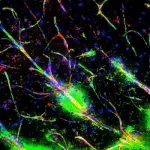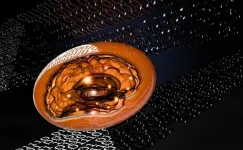(Press-News.org) Coral reefs around the world are under threat from rising sea temperatures, ocean acidification, disease and overfishing, among other reasons.
Tracking signs of stress and ill health is difficult because corals -- an animal host coexisting with algae, bacteria, viruses and fungi -- are dynamic organisms that behave differently depending on what's happening in their environment. Some scientists wonder if recording changes in coral movements over time could help with monitoring a coral reef's health.
This is not always a straightforward task. Some coral species wave and pulse in the current, but others have rock-like skeletons and may have movements that are not visible to the human eye. A new study led by University of Washington researchers borrowed image-analysis methods from engineering to spot the minute movements of a stony coral.
The team published these results April 8 in Scientific Reports.
"In mechanics, we have to be able to measure imperceptible deformations in materials and structures to understand how much load these systems are experiencing and to predict potential failures," said co-senior author Jinkyu Yang, a UW associate professor of aeronautics and astronautics. "We thought we could use these same analysis methods to study living systems, such as corals."
First the researchers needed to find the right coral species to test.
"Our analysis method easily captures surface deformation when whatever we are imaging has texture on its surface. Smooth surfaces without textures, like polished metal and glass, don't work as well," said lead author Shuaifeng Li, a UW doctoral student of aeronautics and astronautics. "Luckily, stony corals, such as Montipora capricornis, have unique patterns on their surfaces."
To get started, the researchers set up a coral photo shoot. They took 200 images of the M. capricornis specimen in a tank at a rate of 30 photos per hour in both daytime and nighttime conditions, which were controlled using different lights.
"It was challenging to keep a sharp focus on the coral due to the way the light refracted off the glass tank," Li said. "Also, we needed to pay particular attention to make sure the lighting conditions were consistent throughout the test."
Once they had acquired the pictures, the researchers used two analysis methods to search for movement. Both methods compare subsequent images in a series to the first image, playing them like a flipbook to extract changes. From here, the team could measure parameters such as pixel velocity, what parts of the coral are moving, and whether something is being compressed or stretched. The researchers also further processed the photos to be able to pull out the different types of movements occurring across the coral.
Across all measurements, the researchers saw more activities happening under the nighttime conditions. The team also saw movement for both the tissue growing on the coral's stony skeleton as well as the coral polyps, though the polyps had larger movements.
"Corals often feed more at night by expanding their polyps and using their tentacles to catch zooplankton prey, and here we are able to quantify these nocturnal movements," said co-senior author Hollie Putnam, assistant professor of biological sciences at the University of Rhode Island. "This application of engineering techniques and analyses to assess subtle and dynamic movements can transform our understanding of coral behavior and physiology, which is critical as corals are under threat from multiple stressors."
The team plans to expand this method to work on more coral species, including soft corals, which have much larger movements. Ultimately, the goal is to make this technique useful for determining potential changes in coral health under different circumstances.
"One investigation that should be considered is looking at how coral tissue motion changes upon exposure to pollutants generated by anthropogenic activities, such as chemical dispersants and oil," Yang said. "Also this method could be used to monitor coral reefs by using satellite images or pictures taken by citizen scientists."
INFORMATION:
Alex Gagnon, a UW assistant professor of chemical oceanography; Liza Roger and Nastassja Lewinski at Virginia Commonwealth University; and Lokender Kumar and Judith Klein-Seetharaman at the Colorado School of Mines are also co-authors on this paper. This research was funded by the National Science Foundation, including a harnessing data revolution grant.
For more information, contact Yang at jkyang@aa.washington.edu, Li at sflee@uw.edu and Putnam at hputnam@uri.edu.
Grant numbers: HDR: DIRSE-IL: 1939249, HDR: DIRSE-IL: 1939795, HDR: DIRSE-IL: 1940169, OCE:CAREER: 1552694, HDR: DIRSE-IL: 1939699
Just as e-cigarette ingredients can vary from one region to another, the health effects of vaping can have regional characteristics as well. A new study out of West Virginia University suggests that rural e-cigarette users are older--and often get sicker--than their urban counterparts.
Researchers with the WVU School of Medicine are investigating severe lung injuries occurring among e-cigarette users in rural Appalachia. In a recent study, Sunil Sharma--section chief of pulmonary/critical care and sleep medicine at the School of Medicine--and his colleagues present a case study of patients with EVALI (electronic cigarettes and vaping-associated lung injury) admitted to WVU hospitals from August 2019 to March 2020. ...
Like a stern bodyguard for the central nervous sytem, the blood-brain barrier keeps out anything that could lead to disease and dangerous inflammation--at least when all is functioning normally.
That may not be the case in people with schizophrenia and other mental disorders, suggest new findings from a team led by researchers from the School of Veterinary Medicine, Perelman School of Medicine, and Children's Hospital of Philadelphia (CHOP). In these individuals, a more permissive barrier appears to allow the immune system to get improperly involved in the central nervous system, the researchers showed. The inflammation that arises likely contributes to the clinical manifestations of neuropsychiatric conditions.
"Our hypothesis was that, if the immune function of the blood-brain ...
WASHINGTON -- Researchers have developed new x-ray optics that can be used to harness extremely fast pulses in a package that is significantly smaller and lighter than conventional devices used to modulate x-rays. The new optics are based on microscopic chip-based devices known as microelectromechanical systems (MEMS).
"Our new ultrafast optics-on-a-chip is poised to enable x-ray research and applications that could have a broad impact on understanding fast-evolving chemical, material and biological processes," said research team leader Jin Wang from the U.S Department of Energy's Argonne National Laboratory. "This could aid in the development of more efficient solar cells and batteries, advanced computer storage materials and devices, ...
Engineered, autonomous machines combined with artificial intelligence have long been a staple of science fiction, and often in the role of villain like the Cylons in the "Battlestar Galactica" reboot, creatures composed of biological and engineered materials. But what if these autonomous soft machines were ... helpful?
This is the vision of a team of Penn State and U.S. Air Force researchers, outlined in a recent paper in Nature Communications. These researchers produced a soft, mechanical metamaterial that can "think" about how forces are applied to it and respond via programmed reactions. ...
People who regularly use psychoactive substances report experiencing a variety of negative impacts since the COVID-19 pandemic began, including increased usage and fear of relapse or overdose, highlighting the need for improved supports and services, including better access to safe supply programs, according to a new CAMH survey published in the International Journal of Drug Policy.
"People who use drugs have been negatively impacted by the pandemic in ways that put them at greater risk for experiencing substance and health-related harms, including overdoses and a decreased ability to mitigate risk behaviours," ...
Leesburg, VA, April 20, 2021--An award-winning Scientific Electronic Exhibit to be presented at the ARRS 2021 Virtual Annual Meeting found non-contrast pituitary MRI for central precocious puberty (CPP), growth hormone deficiency (GHD), and short stature (SS) has similar diagnostic yield compared to the standard contrast-enhanced protocol.
"Microadenomas, a common justification for contrast administration, may not influence management in this patient population," wrote first author Jennifer Huang of Vanderbilt University in Nashville, TN, adding "minimal inconvenience would be added for the few patients who would need to return for contrast-enhanced MRI for definitive diagnosis."
Huang and colleagues performed a retrospective review of pediatric pituitary MRI studies from 2010-2019 ...
Leesburg, VA, April 20, 2021--An award-winning Scientific Electronic Exhibit to be presented at the ARRS 2021 Virtual Annual Meeting found no statistically significant threshold for increased renal transplant biopsy risk based on systolic (SBP), diastolic (DBP), or mean arterial (MAP) blood pressure alone.
"When these metrics are combined," first author Winston Wang of the Mayo Clinic Arizona cautioned, "the risk of complication is significantly higher when the SBP is >= 180 mm Hg, DBP is >= 95 mm Hg, and MAP is >= 116 mm Hg."
Wang and team's review of consecutive ...
Researchers have found a causal link between caesarean section birth, low intestinal microbiota and peanut sensitivity in infants, and they report the effect is more pronounced in children of Asian descent than others, in a recently published paper in the journal of the American Gastroenterological Association.
"It's important to know what predicts or increases risk of food sensitivities because they predict which infants will go on to develop asthma and other types of allergies," said Anita Kozyrskyj, pediatrics professor in the University of Alberta's Faculty of Medicine & Dentistry ...
Professor Bin He's team at Carnegie Mellon University, in collaboration with the Mayo Clinic, has discovered that fast oscillations in scalp-recorded electroencephalography can pinpoint brain tissues responsible for epileptic seizures. The collaborative research, recently published in the Proceedings of the National Academy of Sciences (PNAS), leverages noninvasive EEG technology along with the development of a novel machine learning algorithm to automatically identify and delineate concurrent high-frequency oscillations and epileptiform spikes, a key link related to epilepsy. In the near future, these findings may be harnessed to rethink imaging and treatment options for epilepsy patients.
More than ...
An expansive project led by Michigan State University's Lars Brudvig is examining the benefits, and limits, of environmental restoration on developed land after humans are done with it.
Experts estimate there are up to 17 million square miles of land worldwide that have been altered by humans -- through cultivation say -- and then abandoned. That's more than four times the size of the continental United States.
Once humans change a landscape, their impacts linger long after they've moved on. However, humans can heal some of that damage by working to restore the land to its natural state. ...








